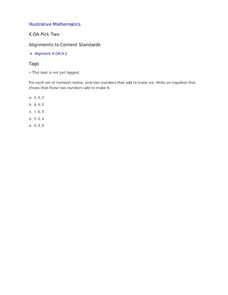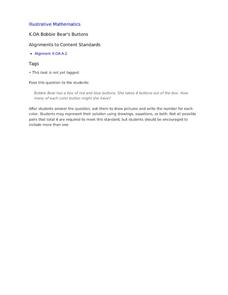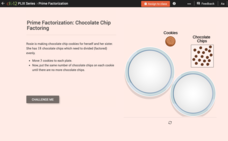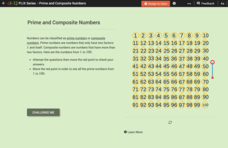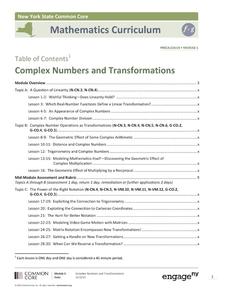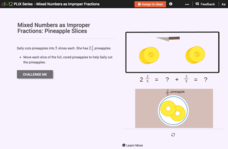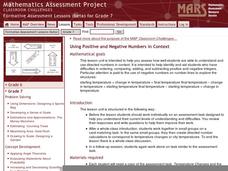Curated OER
Place Value of Whole Numbers Through One Million
Third graders construct numbers to the millions place. In this 30-page place value lesson, learners create numbers and evaluate the place value of digits. They explore standard and expanded form of numbers. An incredible resource!
EngageNY
Comparing Integers and Other Rational Numbers
The ninth installment of a 21-part module has pupils compare integers and rational numbers in decimal and fraction form. They match stories to number lines and compare values in the stories.
Illustrative Mathematics
Numbers in a Multiplication Table
Identifying patterns is a crucial skill for all mathematicians, young and old. Explore the multiplication table with your class, using patterns and symmetry to teach about square numbers, prime numbers, and the commutative and identity...
Illustrative Mathematics
Naming the Whole for a Fraction
How many different ways can you represent a whole? In a picture that represents six parts (two of which are shaded), learners are asked to label the parts appropriately to show how three different mathematical interpretations can be...
Illustrative Mathematics
Irrational Numbers on the Number Line
There are four irrational numbers that participants need to graph. Pi(π), -(½ x π), and √17 are easy to approximate with common rational numbers. On the other hand, the commentary describing the irrational number 2√2 is not clear. It...
Code.org
Binary Numbers
All you need is a zero and a one. Build pupils' understanding of binary values and number systems to gain familiarity with binary numbers. Using a hands-on activity and technology, scholars learn how the binary system works and its place...
CK-12 Foundation
Whole Number Addition: Let's Go Fishing!
Practice adding whole numbers by combining the amount of fish Alice and Bob catch. As young mathematicians work through each problem, they are asked to find one more plus the amount of fish already caught. They can manipulate the...
CK-12 Foundation
Values Written as Powers: Binary Numbers 9 to 16
Challenge mathematicians to crack the binary code with an interactive that focuses on numbers nine to 16. A table reveals exponential equations to aid in answering multiple-choice questions. A discussion question gauges comprehension.
Illustrative Mathematics
Which Number is Greater? Which Number is Less? How do you Know?
When comparing groups of objects, it's easy for children to identify which has more, but it's not so easy for them to explain their reasoning. This simple whole-group activity provides multiple opportunities for learners to compare...
Rational Number Project
Initial Fraction Ideas: Lesson 3
Visual models support young mathematicians as they deepen their fractional number sense in this elementary math lesson. Using fraction circle manipulatives, children explore basic unit fractions as they develop the fundamental...
Illustrative Mathematics
Pick Two
Learning to break apart numbers into smaller pairs is a critical step young mathematicians take as they develop their number sense. To practice this skill, children are provided with sets of three numbers and are asked to pick the two...
Honors College at Scholar Commons
From Start to Strike: A Lesson Plan for the Whole Theatre Experience
Introduce young thespians to all aspects of the theater. A syllabus for a one-semester drama course provides lessons that take learners from the history of drama to the many facets of play production.
Illustrative Mathematics
A Bobbie Bear's Buttons
Young mathematicians help Bobbie Bear pick colored buttons out of a box as they learn how to decompose numbers less than 10 into pairs of smaller numbers. To support students with the process, consider creating a worksheet or graphic...
CK-12 Foundation
Add and Subtract Three Mixed Numbers: Walking to School
Mixed numbers are the focus of a five-question interactive. Scholars move fraction pieces into strips and equations to find solutions. Questions challenge participants with multiple-choice, a true or false, and one discussion.
CK-12 Foundation
Prime Factorization: Chocolate Chip Factoring
An interactive resource challenges mathematicians to show what they know about prime factorization. Five multiple-choice, true or false, and discussion questions use chocolate chip cookies to set a real-world application of the concept.
CK-12 Foundation
Prime and Composite Numbers
Nine true or false, multiple-choice, and discussion questions make up an interactive designed to reinforce scholars' knowledge of prime and composite numbers. A number chart reveals every prime number through 100.
CK-12 Foundation
Whole Number Multiplication: Parity of Zero
An interactive provides five questions that challenge scholars to decide whether integers are even or odd parity. A table assists problem solving with movable numbers that plug into equations and reveal the given parity. Question types...
EngageNY
Complex Numbers and Transformations
Your learners combine their knowledge of real and imaginary numbers and matrices in an activity containing thirty lessons, two assessments (mid-module and end module), and their corresponding rubrics. Centered on complex numbers and...
CK-12 Foundation
Mixed Numbers as Improper Fractions: Pineapple Slices
Practice adding and subtracting improper fractions with pineapple slices. Young mathematicians move whole pineapple slices to visualize the addition of the 2/5s that is on Sally's plate. Pupils also use a combination of mixed numbers and...
Mathematics Assessment Project
Using Positive and Negative Numbers in Context
Measure the temperature of your math class with a temperature-based instructional activity on adding and subtracting rational numbers. The thermometer serves as a vertical number line for learners as they work together to solve a...
Code.org
Encoding Numbers in the Real World
Ah, the numerous number of numbers. Individuals research different ways of encoding numbers. After conducting their initial research, they find classmates who have researched a different article and the pair share information. The...
CK-12 Foundation
Decimals as Mixed Numbers
Five questions—multiple-choice, true or false, and a discussion—make up an interactive that focuses on decimals as mixed numbers. Moveable blocks assist scholars in finding solutions.
CK-12 Foundation
Decimals as Mixed Numbers
A five-question interactive boosts scholars' knowledge of decimals and mixed numbers. Moveable base 10 blocks assist mathematicians in answering a series of multiple-choice and true or false questions. A discussion concludes the practice.
CK-12 Foundation
Values Written as Powers: Binary Numbers 17 to 24
Boost mathematicians' proficiency of binary numbers 17 to 24 with an interactive comprised of six questions—multiple-choice, true or false, and a discussion. A color-coded table reveals binary equivalents to aid in the problem-solving...
Other popular searches
- Matching Numbers to Sets
- Mean of Sets of Numbers
- Matching Numbers With Sets
- Adding Sets of Numbers
- Larger Numbers Describe Sets
- Matching Sets of Numbers
- Identify Sets of Numbers
- Numbers Sets
- Designate Sets of Numbers
- Ordering Sets of Numbers
- Algebra Real Numbers Sets
- Grouping Numbers in Sets












